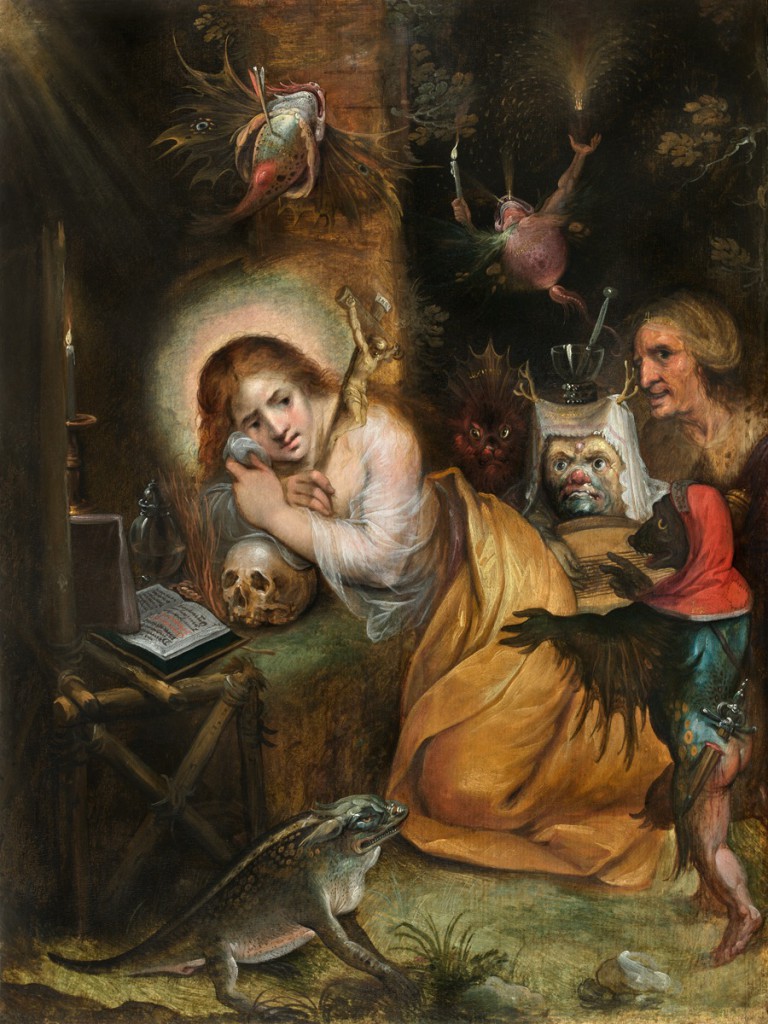Frans Francken the Younger (1581 - Antwerp - 1642)
The Penitent Mary Magdalene visited by the Seven Deadly Sins, c.1607-10
Oil on panel, 44.5 x 33.5 cm
Provenance:
Private collection, Germany
Authenticated by Dr. Ursula Härting
This recently rediscovered, unusually well-preserved work by Frans Francken the Younger was painted in Antwerp, probably in the years 1607-10. The painting depicts Mary Magdalene seated at the entrance to a cave contemplating the Holy Scriptures. Her eyes tear-filled, she leans on a skull and embraces a crucifix, seeking consolation from the threats of demons in the guise of the seven deadly sins. In representing these horrifying figures, Francken consciously references the inventions of Hieronymus Bosch (c.1450-1516) but at the same time, endows them with newly-invented characteristics befitting their role.[1] Weathering the storm of these demonic tribulations, the Magdalene finds solace not only in the Scriptures and the crucifix but also in a ray of divine light descending into the cave from the upper left of the image. Her youth and beauty, embellished by the radiance of her nimbus, are unharmed by these apparitions. Building on a magical language of contrasts, Francken’s painting thus entices the faithful to turn to the consolations of Christianity in the face of adverse conditions. As such, the present work eloquently mirrors the deep, sometimes jarring psychology that permeated the age of the Counter-Reformation.
The subject of the painting amalgamates two short passages in the New Testament with the more expansive description of the Magdalene’s life in the Golden Legend. In the New Testament, Christ is said to have driven seven devils out of her (Mark 16:9; Luke 8:2) while the Golden Legend relates how, after the Ascension of Christ, she subjected herself to thirty years of seclusion and penance in the desert. There, she was kept alive not by food or drink but by prayer and devotion, and by the spiritual joys of being lifted up to heaven by angels seven times a day.
The seven creatures are labelled with small gold letters in period script, indicating that the artist sought to convey their correct identification to those who look closely – a sign that the panel was intended for personal devotion. The extraordinary iconography might relate to a special commission. Significantly, the painting appears to have enjoyed a certain fame among artists of the early seventeenth century since it was reproduced in two surviving early copies[2] - both of considerably inferior quality - suggesting that an even greater number of copies may have existed.
Frans Francken the Younger, the leading member of a distinguished family of painters, was born in Antwerp in 1581. Like his brothers, he was probably trained by his father, Frans Francken the Elder, who ran a successful workshop. Frans the Younger advanced to be a master in 1605 and appears to have spent some time in Holland before setting up as a painter in his native city. He specialized in highly-finished cabinet paintings, often of small format and depicting highly original subject matter. His nomination as Dean of the painters’ Guild of St. Luke in 1614/15 can be interpreted as an expression of the high regard in which he was held in artistic circles. After his father’s death in 1616, he further consolidated his prominence, directing one of the principal workshops of seventeenth-century Antwerp.
Dr. Ursula Härting has examined the painting and confirmed its authenticity.
[1] Superbia (arrogance), attempting to rise above the Magdalene, is restrained by an arrow that has penetrated its chest; Invidia (envy), breathing fire, holds up two lights that fail to illuminate the surrounding darkness; Luxuria (lust), clad in fur, stares with frustrated eyes at the scene; Gula (gluttony), disfigured by blue, yellow and red spots, is shown playing the lute, flanked by Avaritia (greed) and Ira (wrath) who appear to sing to her tune; finally, Acedia (sloth) sits on the ground, observing Ira with a devilish smile.
[2] Both copies are documented in the photographic library of the Rijksbureau voor Kunsthistorische Dokumentatie (RKD) in The Hague. One copy (filled with images of works by David Teniers) is now in a private collection in Switzerland (45.4 x 34.8 cm). The other copy (filled with images of the Magdalene) was offered at auction by Fischer, Lucerne in 1997 (20 November, lot 1002, 63 x 52.5 cm).

